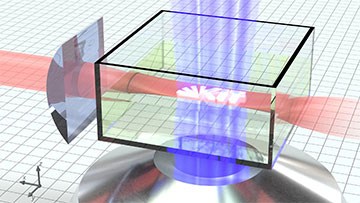
In light-sheet 3D printing, red and blue lasers are used to print objects precisely and quickly on a micrometer scale. [Image: V. Hahn, Karlsruhe Institute of Technology, Germany]
A team of researchers in Germany and Australia has developed and demonstrated a new high-speed, high-resolution additive manufacturing method for printing detailed polymer microstructures in milliseconds (Nat. Photon., doi: 10.1038/s41566-022-01081-0).
The optics-based printing process uses a blue laser to project layers of a small 3D object into a vat of liquid resin. A sheet of red laser light then crosses the blue light projections and cures the resin in a few hundred milliseconds as the light sheet passes through the vat.
“With more sensitive resins, we could even use LEDs instead of lasers in our 3D printer,” said Martin Wegener, Karlsruhe Institute of Technology (KIT), Germany. “Ultimately, we want to print 3D structures that are centimeters in size, while maintaining micrometer resolution and high printing speeds.”
Fast optics-based 3D printing
Additive manufacturing processes for plastic objects typically use stereolithographic 3D-printing technology. The process involves projecting layers of a 3D image into liquid resin and curing the resin layers individually with UV light. The process, unsurprisingly, is not particularly fast.
Wegener and his colleagues at KIT and Ruprecht-Karls-Universität Heidelberg, Germany, aimed to speed up this process using light-sheet 3D microprinting technology which combines image projection with two-color, two-step absorption.
For their microprinting platform, the team combined continuous-wave blue lasers at 440 nm for object protection into a container of liquid photoresin, a continuous-wave red laser at 660 nm for the light sheet and biacetyl as the photo initiator. With two-color, two-step absorption, the liquid resin only solidifies in areas that are simultaneously exposed to both the blue and the red lasers.
In resolution demonstrations, the researchers achieved an overall printing time of less than one second per microstructure.
Boat-printing demonstrations and size limitations
In demonstrations of their light-sheet 3D laser microprinter, the team used a highly viscous photoresin called PR3 for its long intrinsic polymerization time constant. This property yielded little change in the refractive index during the exposure phase of printing, lowering the scattering effects of the red-light sheet at already polymerized sites on the object.
“For the resin we used, the return time was less than 100 µs, which allows for high printing speeds,” said KIT’s Vincent Han, first author of the paper. Han and his team members achieved a peak printing rate of 7×106 voxels per second at a voxel volume of 0.55 µm3 with their platform.
During demonstrations, the researchers created several micro-objects with their platform, including a fleet of five “#3DBenchy” boats—a benchmark structure in the 3D-printing community. Each boat was printed in 266 μs. Scanning electron microscope images revealed the boats had consistent and detailed shapes.
While the light-sheet 3D laser microprinter is fast, the team acknowledges that structure size is limited by the gradual accumulation of photoresin at the bottom of the resin vat, which leads to impaired optical resolution of the projected image. They hope to address these limitations in future iterations of the printing platform.
